Dominique Luchart's Blog, page 594
June 16, 2021
Windows 11’s default wallpapers are Microsoft’s best yet, Tom Warren


Windows 11 leaked yesterday, offering a closer look at some of the UI changes Microsoft is planning for its next version of Windows. The leak has also revealed what will likely become Microsoft’s default wallpaper for Windows 11, and a collection of new wallpapers that are bundled with the operating system. They’re Microsoft’s best Windows wallpapers yet.
The main default wallpaper includes light and dark mode versions, with what looks like a crumpled piece of fabric. It’s a big departure from the Windows logo that was used as the default in Windows 10, or the two daisy flowers in Windows 8.
You can download the full-size versions in the gallery above.
Microsoft has also included a collection of other wallpapers inside Windows 11. The…
The post Windows 11’s default wallpapers are Microsoft’s best yet, Tom Warren appeared first on NEWDAWN Blog.
Windows 11’s default wallpapers are Microsoft’s best yet,

Windows 11 leaked yesterday, offering a closer look at some of the UI changes Microsoft is planning for its next version of Windows. The leak has also revealed what will likely become Microsoft’s default wallpaper for Windows 11, and a collection of new wallpapers that are bundled with the operating system. They’re Microsoft’s best Windows wallpapers yet.
The main default wallpaper includes light and dark mode versions, with what looks like a crumpled piece of fabric. It’s a big departure from the Windows logo that was used as the default in Windows 10, or the two daisy flowers in Windows 8.
You can download the full-size versions in the gallery above.
Microsoft has also included a collection of other wallpapers inside Windows 11. The “Captured Motion” set offer a more colorful option, and the “Flow” collection are a more subtle take on the default. “Glow” is a set of four colorful orbs that light up the Windows 11 backdrop, and the “Sunrise” collection are a clear nod to the Sun Valley codename for the Windows 11 UI work.
As this is an early and incomplete version of Windows 11, it’s not clear how many of these images will ship in the final version. These already look better than the flowers and scenic backgrounds included in Windows 10, and fit the overall UI changes to Windows 11. If you haven’t seen exactly what Microsoft is changing in Windows 11, check out our hands-on to see the new UI, Start menu, and more.
The post Windows 11’s default wallpapers are Microsoft’s best yet, appeared first on NEWDAWN Blog.
New website tracks which colleges will use eproctoring software this fall, Monica Chin


Privacy-focused nonprofit Fight for the Future has launched a new website that tracks whether certain colleges and universities plan to use virtual proctoring software during the fall semester.
The platforms — like ProctorU and Proctorio — often make use of students’ webcams to watch and record them as they work, using automated systems or live monitors to flag possible signs of cheating. The practice has sparked controversy in the US, with critics in both academia and government citing privacy concerns and the potential for such software to discriminate against marginalized students. Still, some colleges began using eproctoring last year to watch for dishonesty on take-home exams, after moving testing online due to COVID-19.
Many…
The post New website tracks which colleges will use eproctoring software this fall, Monica Chin appeared first on NEWDAWN Blog.
New website tracks which colleges will use eproctoring software this fall,

Privacy-focused nonprofit Fight for the Future has launched a new website that tracks whether certain colleges and universities plan to use virtual proctoring software during the fall semester.
The platforms — like ProctorU and Proctorio — often make use of students’ webcams to watch and record them as they work, using automated systems or live monitors to flag possible signs of cheating. The practice has sparked controversy in the US, with critics in both academia and government citing privacy concerns and the potential for such software to discriminate against marginalized students. Still, some colleges began using eproctoring last year to watch for dishonesty on take-home exams, after moving testing online due to COVID-19.
Many schools will resume in-person examinations this fall due to the wide availability of COVID-19 vaccines, but it seems that some plan to continue using eproctoring software in some capacity. Fight for the Future says it has asked a number of colleges about their plans and has stamped each one with labels for “Won’t Use,” “Might Use,” and “Are Using.” (Colleges that haven’t responded to Fight for the Future’s inquiries got a “Might Use.”) Viewers are prompted to tweet at and email each university to denounce the software’s use.
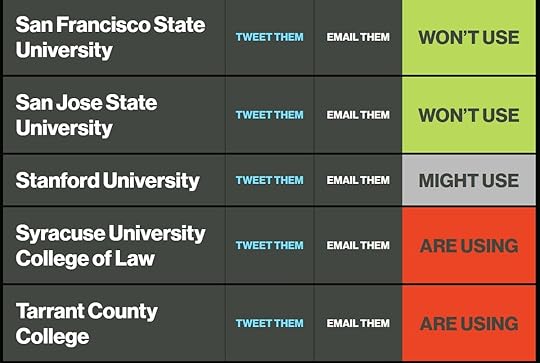
Also on the front page is a “webcam image test” meant to determine whether eproctoring algorithms could accurately identify a viewer’s face (following reports that such algorithms disproportionately fail to identify faces with darker skin tones). Fight for the Future says the test uses the same computer vision software used by prominent eproctoring platform Proctorio, but insists that it doesn’t collect any data from the widget.
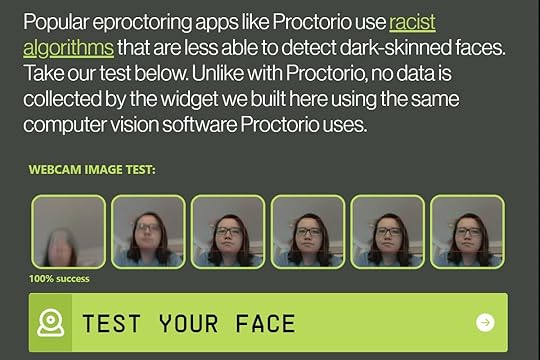
The website also urges followers to sign a petition addressed to school administrators and to submit “eproctoring horror stories” to the organization.
The post New website tracks which colleges will use eproctoring software this fall, appeared first on NEWDAWN Blog.
June 15, 2021
Sony reportedly plans PSVR successor for next holiday season, Sam Byford
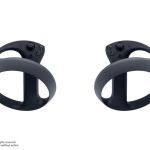
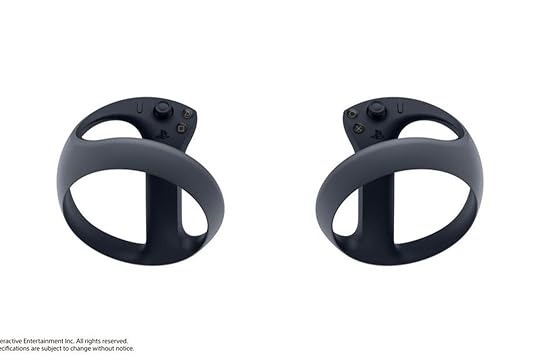 Sony’s next-gen VR controllers. | Image: Sony
Sony’s next-gen VR controllers. | Image: SonySony’s next-gen PlayStation VR headset is likely to come out in late 2022, according to a new report. Bloomberg’s sources say Sony is “aiming to release the successor in the holiday period next year,” and that the headset will use OLED panels from Samsung Display.
A release in that timeframe wouldn’t be too surprising, since Sony has already started talking up the PS5 headset’s potential. Its existence was first confirmed in February along with some initial details, and Sony followed up by showing off the new controllers in March.
The headset itself hasn’t yet been revealed. But according to an UploadVR report from last month, it’ll have a total resolution of 4000 x 2040 and make use of eye tracking to enable foveated rendering, which…
The post Sony reportedly plans PSVR successor for next holiday season, Sam Byford appeared first on NEWDAWN Blog.
Looking at the stars, or falling by the wayside? How astronomy is failing female scientists, ,
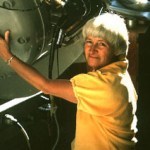
This article was originally published at The Conversation. The publication contributed the article to Space.com’s Expert Voices: Op-Ed & Insights .
Lisa Kewley , Director, ARC Centre for Excellence in All-Sky Astrophysics in 3D, Australian National University
It will take until at least 2080 before women make up just one-third of Australia’s professional astronomers unless there is a significant boost to how we nurture female researchers’ careers.
Over the past decade, astronomy has been rightly recognized as leading the push towards gender equity in the sciences. But my new modeling, published in Nature Astronomy, shows it is not working fast enough.
Related: 20 trailblazing women in astronomy and astrophysics
The Australian Academy of Science’s decadal plan for astronomy in Australia proposes women should comprise one-third of the senior workforce by 2025.
It’s a worthy, if modest, target. However, with new data from the academy’s Science in Australia Gender Equity (SAGE) program, I have modeled the effects of current hiring rates and practices and arrived at a depressing, if perhaps not surprising, conclusion. Without a change to the current mechanisms, it will take at least 60 years to reach that 30% level.
However, the modeling also suggests that the introduction of ambitious, affirmative hiring programs aimed at recruiting and retaining talented women astronomers could see the target reached in just over a decade — and then growing to 50% in a quarter of a century.
How did we get here?Before looking at how that might be done, it’s worth examining how the gender imbalance in physics arose in the first place. To put it bluntly: how did we get to a situation in which 40% of astronomy PhDs are awarded to women, yet they occupy fewer than 20% of senior positions?
On a broad level, the answer is simple: my analysis shows women depart astronomy at two to three times the rate of men. In Australia, from postdoc status to assistant professor level, 62% of women leave the field, compared with just 17% of men. Between assistant professor and full professor level, 47% of women leave; the male departure rate is about half that. Women’s departure rates are similar in US astronomy.
Read more: ‘Death by a thousand cuts’: women of color in science face a subtly hostile work environment
The next question is: why?
Many women leave out of sheer disillusionment. Women in physics and astronomy say their careers progress more slowly than those of male colleagues, and that the culture is not welcoming.
They receive fewer career resources and opportunities. Randomized double-blind trials and broad research studies in astronomy and across the sciences show implicit bias in astronomy, which means more men are published, cited, invited to speak at conferences, and given telescope time.
It’s hard to build a solid research-based body of work when one’s access to tools and recognition is disproportionately limited.
[image error]
Women astronomers get disproportionately less telescope time than their male colleagues. (Image credit: ESO/C. Malin)The loyalty problemThere is another factor that sometimes contributes to the loss of women astronomers: loyalty. In situations where a woman’s male partner is offered a new job in another town or city, the woman more frequently gives up her work to facilitate the move.
Encouraging universities or research institutes to help partners find suitable work nearby is thus one of the strategies I (and others) have suggested to help recruit women astrophysicists.
But the bigger task at hand requires institutions to identify, tackle and overcome inherent bias — a legacy of a conservative academic tradition that, research shows, is weighted towards men.
A key mechanism to achieve this was introduced in 2014 by the Astronomical Society of Australia. It devised a voluntary rating and assessment system known as the Pleiades Awards, which rewards institutions for taking concrete actions to advance the careers of women and close the gender gap.
Initiatives include longer-term postdoctoral positions with part-time options, support for returning to astronomy research after career breaks, increasing the fraction of permanent positions relative to fixed-term contracts, offering women-only permanent positions, recruitment of women directly to professorial levels, and mentoring of women for promotion to the highest levels.
Most if not all Australian organizations that employ astronomers have signed up to the Pleiades Awards, and are showing genuine commitment to change.
So why is progress still so slow?Seven years on, we would expect to have seen an increase in women recruited to, and retained in, senior positions.
And we are, but the effect is far from uniform. My own organization, the ARC Centre of Excellence in All-Sky Astrophysics in 3 Dimensions (ASTRO 3D), is on track for a 50:50 women-to-men ratio working at senior levels by the end of this year.
The University of Sydney School of Physics has made nine senior appointments over the past three years, seven of them women.
But these examples are outliers. At many institutions, inequitable hiring ratios and high departure rates persist despite a large pool of women astronomers at postdoc levels and the positive encouragement of the Pleiades Awards.
Using these results and my new workforce models, I have shown current targets of 33% or 50% of women at all levels are unattainable if the status quo remains.
How to move forwardI propose a raft of affirmative measures to increase the presence of women at all senior levels in Australian astronomy — and keep them there.
These include creating multiple women-only roles, creating prestigious senior positions for women, and hiring into multiple positions for men and women to avoid perceptions of tokenism. Improved workplace flexibility is crucial to allowing female researchers to develop their careers while balancing other responsibilities.
Australia is far from unique when it comes to dealing with gender disparities in astronomy. Broadly similar situations persist in China, the United States and Europe. An April 2019 paper outlined similar discrimination experienced by women astronomers in Europe.
Australia, however, is well placed to play a leading role in correcting the imbalance. With the right action, it wouldn’t take long to make our approach to gender equity as world-leading as our research.
This article is republished from The Conversation under a Creative Commons license. Read the original article .
Follow all of the Expert Voices issues and debates — and become part of the discussion — on Facebook and Twitter. The views expressed are those of the author and do not necessarily reflect the views of the publisher.
The post Looking at the stars, or falling by the wayside? How astronomy is failing female scientists, , appeared first on NEWDAWN Blog.
This simple dock turns your Apple Watch into a bedside orb, Jon Porter
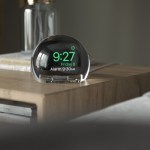
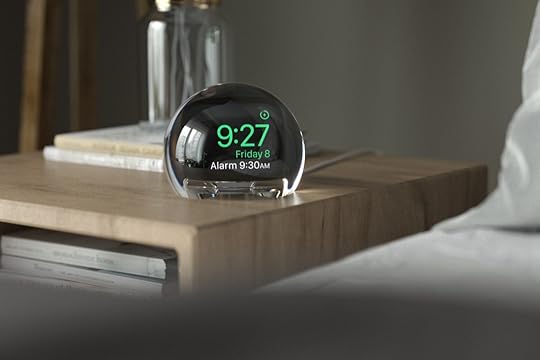 Slot in your Apple Watch, and the NightWatch magnifies its screen. | Image: NightWatch
Slot in your Apple Watch, and the NightWatch magnifies its screen. | Image: NightWatchHave you ever tried using your Apple Watch as a bedside clock, but given up because the screen is just too dang small? Well, boy do we have a $49.99 dock for you. The NightWatch is combination charging dock, magnifying glass, and acoustic amplifier, bringing together these functions to turn the Apple Watch’s nightstand mode into a bona fide bedside alarm, complete with a tap-to-wake feature to show you the time.
We’ve previously covered novelty docks that turn the Apple Watch into a miniature Macintosh replica or an iPod. But the NightWatch attempts to make the Apple Watch work better in nightstand mode, by making its screen bigger and easier to read and using “integrated sound channels’ to amplify the sound of your alarm.
…
The post This simple dock turns your Apple Watch into a bedside orb, Jon Porter appeared first on NEWDAWN Blog.
Amazon brings its cashierless tech to a full-size grocery store for the first time, Jon Porter

 Image: Amazon
Image: AmazonAmazon’s cashierless Just Walk Out technology is coming to a full-size grocery store for the first time, the company has announced. The new 25,000 square foot Amazon Fresh store is significantly bigger than the 10,400 square foot Amazon Go Grocery store it opened last year, or its standard 1,200 and 2,300 square feet Go stores, marking a minor milestone as Amazon scales up its technology. The new store will be Amazon’s fourteenth Fresh location in the US when it opens on June 17th in Bellevue, Washington.
When Amazon previously opened a 35,000 square foot Amazon Fresh store last year using its high-tech Dash Carts, it prompted speculation that the company’s Just Walk Out technology wasn’t suitable for larger stores. But Amazon has always…
The post Amazon brings its cashierless tech to a full-size grocery store for the first time, Jon Porter appeared first on NEWDAWN Blog.
Amazon brings its cashierless tech to a full-size grocery store for the first time,

Amazon’s cashierless Just Walk Out technology is coming to a full-size grocery store for the first time, the company has announced. The new 25,000 square foot Amazon Fresh store is significantly bigger than the 10,400 square foot Amazon Go Grocery store it opened last year, or its standard 1,200 and 2,300 square feet Go stores, marking a minor milestone as Amazon scales up its technology. The new store will be Amazon’s fourteenth Fresh location in the US when it opens on June 17th in Bellevue, Washington.
When Amazon previously opened a 35,000 square foot Amazon Fresh store last year using its high-tech Dash Carts, it prompted speculation that the company’s Just Walk Out technology wasn’t suitable for larger stores. But Amazon has always maintained that Just Walk Out, which uses a series of overhead cameras and pressure sensitive shelves to automatically detect what shoppers put in their carts, can scale up to stores of any size.
“Bringing Just Walk Out technology to a full-size grocery space with the Amazon Fresh store in Bellevue showcases the technology’s continued ability to scale and adapt to new environments and selection” said Amazon’s vice president of Physical Retail and Technology, Dilip Kumar. “I’m thrilled it’ll help even more customers enjoy an easier and faster way to shop and can’t wait to get their feedback on this latest Just Walk Out offering.”
Amazon says that when customers arrive at the new store in Bellevue, Washington, they’ll be prompted to pick a checkout option, and that traditional checkouts will still be available for customers that want them. If they decide to use Just Walk Out, they can enter the store by scanning a QR code in the Amazon app, inserting a linked credit or debit card, or scanning their palm. Once they leave the store, they’re automatically billed for the items in their virtual cart, and a receipt is sent digitally to them.
The new store uses of Just Walk Out, but it won’t feature the high-tech Dash shopping carts Amazon debuted in its first Fresh grocery store last August. Amazon declined to say whether it would be bringing Just Walk Out tech to its pre-existing Amazon Fresh stores in the US. Meanwhile in the UK, the technology appears in Fresh-branded locations that are similar in size to Amazon’s Go stores in the US.
In addition to Amazon’s own stores, the company also provides Just Walk Out to third-party retailers. Amazon says Hudson markets, OTG CIBO Express, and Delaware North are three external retailers that have started to roll out the technology at various locations.
The post Amazon brings its cashierless tech to a full-size grocery store for the first time, appeared first on NEWDAWN Blog.
June 14, 2021
Mushrooms on Mars? 5 unproven claims that alien life exists, ,
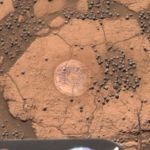
This article was originally published at The Conversation. The publication contributed the article to Space.com’s Expert Voices: Op-Ed & Insights .
Gareth Dorrian , Postdoctoral Research Fellow in Space Science, University of Birmingham
A recent study claims to have found evidence for mushroom-like life forms on the surface of Mars. As it happens, these particular features are well known and were discovered by cameras aboard NASA’s Mars Exploration Rover Opportunity, shortly after it landed in 2004.
They are not, in fact, living organisms at all, but “hematite concretions” — small sphere-shaped pieces of the mineral hematite, and their exact origin is still debated by scientists. Hematite is a compound of iron and oxygen and is commercially important on Earth. The spherical rocks on Mars may have been created by the gradual accumulation of the material in slowly evaporating liquid water environments. They could also have been produced by volcanic activity.
Either way, mushrooms they are not. The area around Opportunity’s landing site is littered with them they can be seen all over the surface and were also found buried beneath the soil and even embedded within rocks.
Related: The weirdest Mars discoveries by NASA’s Opportunity and Spirit rovers
Fossilized wormsThese space “mushrooms” were not the first claim of alien life. On August 7, 1996, the then US president Bill Clinton stood on the White House lawn and announced the possibility that scientists had discovered the ancient, fossilized remains of micro-organisms in a meteorite that had been recovered from Antarctica in 1984.
The meteorite, ALH 84001, is one of a handful of rocks we have from Mars. These were blasted off the surface of the planet by volcanic eruptions or meteorite impacts, drifted through space probably for millions of years, before ending up on Earth.
[image error]
High-resolution scanning electron microscope image of the structures. (Image credit: NASA)The tiny structures discovered within, using powerful microscopes, resemble microscopic worm-like organisms and are likely to be billions of years old. Debate over the true origins of these structures continues today — many scientists have pointed out that well-known inorganic processes are quite capable of producing structures that resemble living organisms. In other words, simply because something might look a bit like life (mushrooms or otherwise), that does not mean it is.
Mystery gasesIn the 1970s NASA’s Viking robotic landers carried a series of experiments designed to test the Martian soil for the presence of microorganisms.
The experiments chemically treated small samples of Martian soil in reaction chambers on board the landers. In one of them, nutrients containing radioactive carbon-14 were added to the soil samples. In theory, this should be absorbed by any growing and multiplying microbes. The carbon-14 would then increasingly be “breathed out” over time, showing a steady increase in concentration within the reaction chamber.
After the chemical analyses, each soil sample was steadily heated to hundreds of degrees to destroy any microbes, with the intention of seeing whether any such reactions in the soil ceased. Intriguingly, this particular experiment did show a steady increase in carbon-14 over time which was indeed terminated after heating to above the boiling point of water. Several inorganic chemical reactions have been proposed as an explanation. These results therefore remain inconclusive and are still debated today.
More recently, minute quantities of methane have been found in the Martian atmosphere. This is also intriguing as living organisms on Earth are known to release methane. Once again, however, it must be stressed that this not conclusive proof of life. Methane can also be produced by several inorganic processes, including by heated rocks.
Wow!In 1977, the Big Ear radio telescope in the US detected an unusual radio signal while scanning the sky. The signal lasted for just a couple of minutes, was very high-powered and was detected over a narrow range of frequencies. These factors make it quite difficult to envisage a natural cause, as most natural radio sources can be detected across a wide range of frequencies.
The exact signal has not been detected again since, despite frequent radio surveys of the same part of the sky. The signal was so remarkable at the time that the astronomer on duty, Jerry Ehman, circled the printout of the signal with a red pen and wrote “Wow!” next to it.
Various explanations have been proposed over the years including, recently, that the signal was generated by a passing comet, or transmissions from an Earth-orbiting satellite. The exact origin of the Wow! signal is still not fully agreed upon today and remains an intriguing mystery.
Tabby’s StarA key tool of planet-hunting is the dimming method — observing light from a star to see if it periodically dips in a regular fashion as an orbiting planet passes in front of it. In 2015, professional astronomers working with citizen scientists from the Planet Hunters project announced the discovery of a nearby star displaying unusually strong and consistent dimming over time.
Tabby’s Star is named after astronomer Tabitha Boyajian who was the lead author on the paper announcing the discovery. Data from the Kepler Space Telescope showed not just a regular dimming, as one might expect from a planetary orbit, but highly irregular dips in the light and, interestingly, a consistent decrease in light output over several years.
Related: The Puzzle of ‘Tabby’s Star’: 9 explanations for star’s odd dimming
This highly unusual behavior prompted numerous theories to explain the observations, including cometary dust or debris from a massive impact gradually spreading out to cover the face of the star. Some also speculated that these were signatures of an advanced alien species building a structure around the star. But further observations have found no corroborating evidence to support this possibility. For example, radio telescopes have failed to detect any unusual radio emissions from the star. Today, the scientists behind the discovery believe that the unusual dips in light are caused by clouds of cosmic dust passing across the face of the star.
As exciting as they are, it is important to treat claims of alien life with a healthy dose of skepticism, and this is indeed what scientists do. No conclusive evidence that extraterrestrial life exists has been found … yet.
This article is republished from The Conversation under a Creative Commons license. Read the original article .
Follow all of the Expert Voices issues and debates — and become part of the discussion — on Facebook and Twitter . The views expressed are those of the author and do not necessarily reflect the views of the publisher. This version of the article was originally published on Live Science .
The post Mushrooms on Mars? 5 unproven claims that alien life exists, , appeared first on NEWDAWN Blog.



